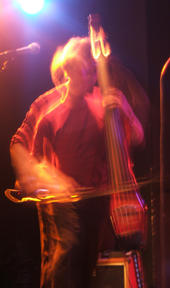New Stereo Mixes uploaded |
Hello all,Yesterday I worked with Rob Ruccia at Uptown Recording in Chicago to transfer some of my old four-track cassette recordings into digital format. Doing this myself previously, I had been unab...
Posted by Douglas Johnson on Sat, 29 Dec 2007 08:11:00 PST |
Planetary Frequencies and Tempi |
Planetary Pitches and TempiUsing the basic math of doubling or halving numbers, one can derive pitches and tempi from the durations of planetary orbits. While orbits are not sound waves, they ar...
Posted by Douglas Johnson on Fri, 16 Nov 2007 06:49:00 PST |
"Into the Agape" to be featured on Bowed Radio Podcast |
Hello all, just a heads up that "Into the Agape" will be on the November 19th Bowed Radio podcast. Produced by Mark Allender, the podcast features string music from all over the world. Other featured ...
Posted by Douglas Johnson on Wed, 14 Nov 2007 06:57:00 PST |
Harmonic Ratios |
Harmonic Ratios OK, so if the pitch of an individual note or tone is measured in vibrations per second, or Hertz (hz), then what are the frequency relationships of two different tones sounding at the...
Posted by Douglas Johnson on Tue, 13 Nov 2007 10:07:00 PST |
World Premiere Bass Quartet |
Hey, just a heads up that I'll be playing a really cool concert with the Chicago Bass Ensemble on Wednesday, November 7th, 2007, at the Lincoln Park Cultural Center in Chicago. The performance is free...
Posted by Douglas Johnson on Fri, 02 Nov 2007 05:51:00 PST |
Pitch to Tempi Relationships |
OK, this blog is mostly for musicians and other folks who find "frequencies" and such to be interesting. It contains simple math as well ().Anyway, pitches in music are measured in frequencies, or mor...
Posted by Douglas Johnson on Mon, 17 Sep 2007 06:08:00 PST |
Creating Complex Meters |
Most Western music is in 4. Probably because we're bipedal, it's easy to dance to, and makes it real easy to have a backbeat. Waltzes and some other types of music are in 3. So we live mostly in a wor...
Posted by Douglas Johnson on Sat, 11 Aug 2007 08:02:00 PST |
Falling Behind on the Space |
Hello all - I'm about a month behind on my friend requests. I get to it when I can, but try to take the time to listen to the music of fellow musicians and such. Be well, dj
Posted by Douglas Johnson on Mon, 16 Apr 2007 06:41:00 PST |
Introduction to Polyrhythm |
Introduction to Polyrhythm Polyrhythm consists of simultaneous contrasting rhythms. They form the basis of most African music, as well as a lot of Western "minimalist" music, such as Steve Reich and P...
Posted by Douglas Johnson on Tue, 28 Nov 2006 07:08:00 PST |
Turn Your Name into Music |
Turn Your Name Into Music In German notation, the following letters of the alphabet correspond to musical pitches. One can create melodies or chord progressions from any word or phrase matching letter...
Posted by Douglas Johnson on Sat, 25 Nov 2006 07:59:00 PST |
